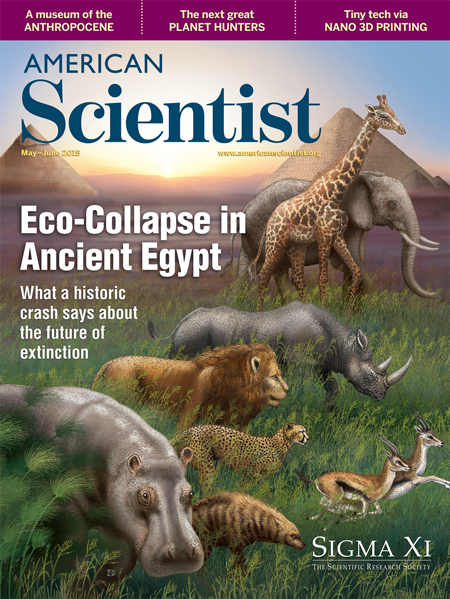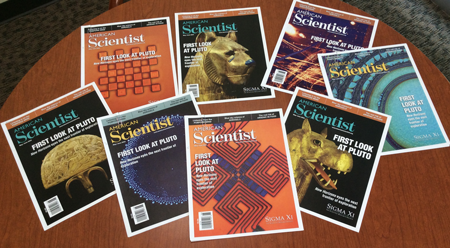The Voodoo Science of Choosing a Successful Cover
By Barbara Aulicino
Inspiration for a cover doesn’t always come right away, and at first nothing was quickening the pulse for the May–June issue of American Scientist. Although the topics themselves were compelling, consider the imagery conjured up by our feature article lineup...
April 27, 2015
From The Staff Communications Aesthetics
Inspiration for a cover doesn’t always come right away, and at first nothing was quickening the pulse for the May–June issue of American Scientist. Although the topics themselves were compelling, consider the imagery conjured up by our feature article lineup: Taste aversion and sickness? Yuck! Fatigue in the workplace? Yawn. The next great exoplanet hunt? Not an option. (Our January–February cover had featured images of Pluto and Charon, so it was too soon to run another space cover.) Nanoscale fabrication? Just finding an opening image for that article had been tough. A cover? Fuhgeddaboutit!

Sitting in lotus position and meditating on my Vishudda chakra (you know, the one that governs creative expression—nice light blue color?) wasn’t helping. Divine inspiration finally came in the form of interim editor Corey Powell (@coreyspowell) and editor-in-chief Jamie Vernon (@jlvernonphd) suggesting a focus on Justin Yeakel and Jennifer Dunne’s article about ancient food webs and steering me toward artist Dominique Navarro.
Dominique and I decided to try repurposing some of her Egyptian flora and fauna illustrations from American University in Cairo Press’s Nature Foldout series. She sent mockups and we tweaked. After six rounds of refinements, we settled on an Egyptian landscape with a shortened depth of field to create a perception of compressed space and time. Representing the shift from a humid to an arid climate, the image depicts larger-bodied mammals from the African Humid Period—some of them destined for extinction because of the climatic changes—as they push through flank-high grasses, moving left to right across the landscape.
Of course it’s always good to have a backup plan in case Plan A doesn’t pan out. Here’s a look at some of the options we had on hand for Plan B.

Fortunately, Plan A, with Dominique’s excellent illustrations, made for a distinctive cover that we hope will help the issue sell out on the newsstand. This month American Scientist should be particularly easy to find, as it’s being specially featured in selected Barnes & Noble stores. Our May–June issue goes on sale tomorrow—look for it in the science section of a newsstand near you.
American Scientist Comments and Discussion
To discuss our articles or comment on them, please share them and tag American Scientist on social media platforms. Here are links to our profiles on Twitter, Facebook, and LinkedIn.
If we re-share your post, we will moderate comments/discussion following our comments policy.